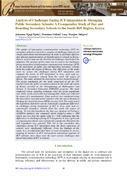| dc.contributor.author | Njoka, Johannes Njagi | |
| dc.contributor.author | Githui, Perminus | |
| dc.contributor.author | Ndegwa, Lucy Wanjira | |
| dc.date.accessioned | 2020-10-22T06:50:42Z | |
| dc.date.available | 2020-10-22T06:50:42Z | |
| dc.date.issued | 2020-02 | |
| dc.identifier.citation | Budapest International Research and Critics Institute-Journal (BIRCI-Journal) Volume 3, No 1, February 2020, Page: 58-66 | en_US |
| dc.identifier.issn | 2615-3076 | |
| dc.identifier.issn | 2615-1715 | |
| dc.identifier.uri | https://karuspace.karu.ac.ke/handle/20.500.12092/2437 | |
| dc.description.abstract | The uptake of information communication technology (ICT) by secondary schools is beset by a complex of challenges that are not
clearly understood and documented. In order to facilitate effective and efficient implementation of digitalization in schools in Kenya, there is need to map out the diversity of challenges that bedevil its adoption. The purpose of this study was to analyze the challenges facing integration of information communication technology (ICT) in the operations of public day and boarding secondary schools from the south rift region of Kenya. The objectives of the study were to; assess the challenges facing ICT integration and compare the levels of ICT integration in boys, girls and coeducational secondary schools from the south rift region of Kenya. The study adopted the descriptive survey research design. The target population for the study comprised of all the 141
teachers from the public secondary schools in the south rift region of Kenya enrolled in the Strengthening of Mathematics and
Science in Secondary Education (SMASSE) program. The study employed census sampling technique since the target population
was small, easily accessible and manageable. Data was collected by means of a questionnaire. Data analysis was conducted using the descriptive and inferential statistics with the aid of Statistical Package for Social Sciences (SPSS) version 21.0. The study tested the hypothesis that there was no statistically significant difference in challenges facing integration of ICT in boys, girls and coeducational secondary schools from the south rift region of Kenya. To test this hypothesis the One way Analysis of Variance (ANOVA) statistics was computed which yielded p-value = .000
which was less than the alpha value α > 0.05 indicating that the differences in challenges facing ICT integration in boys, girls and
co-educational schools were statistically significant. Therefore the null hypothesis was rejected. This led to the conclusion that
challenges facing ICT integration from the three categories of schools were significantly different. From the findings of the
study, it is recommended that there is need strengthen in service training of teachers in ICT and perform widespread upgrade of
ICT software since these were the most serious challenges that faced integration of ICT in schools. | en_US |
| dc.language.iso | en | en_US |
| dc.publisher | Budapest International Research and Critics Institute-Journal | en_US |
| dc.subject | challenges; | en_US |
| dc.subject | digitalization | en_US |
| dc.subject | information communication | en_US |
| dc.subject | technology; | en_US |
| dc.subject | ICT integration | en_US |
| dc.title | Analysis of Challenges Facing ICT integration in Managing Public Secondary Schools: A Comparative Study of Day and Boarding Secondary Schools in the South Rift Region, Kenya | en_US |
| dc.type | Article | en_US |
